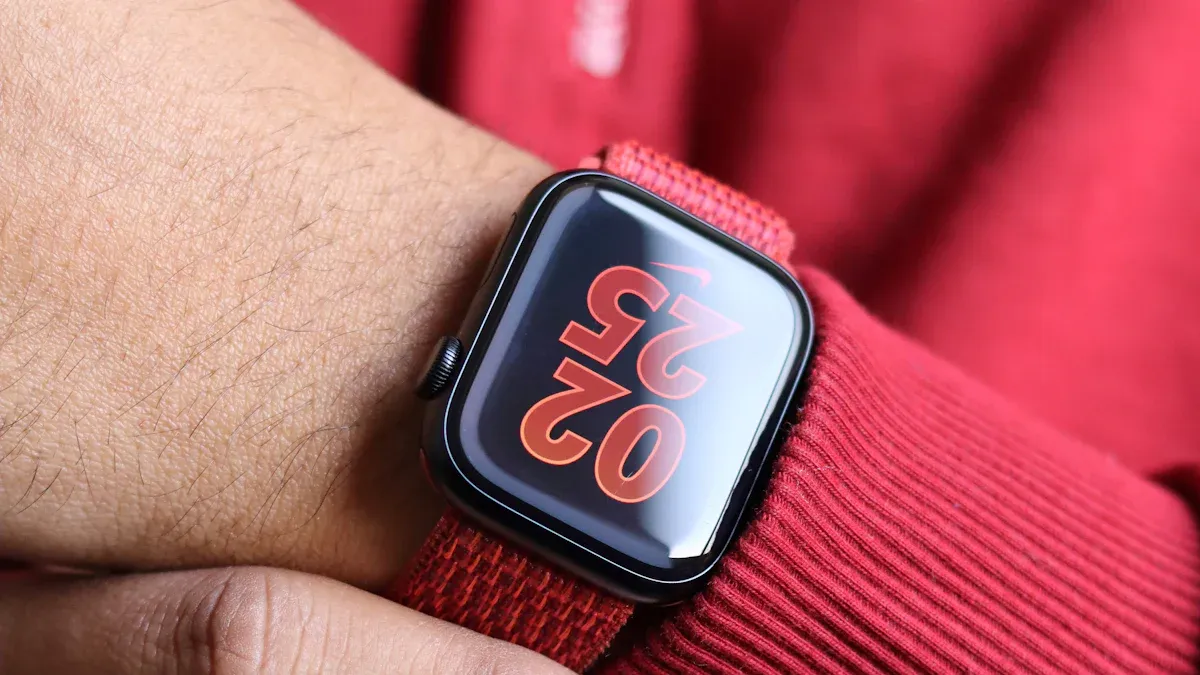
You expect wearable devices to give every patient more freedom, but traditional batteries often limit comfort and usability. Custom battery shapes now let you design wearables that fit each patient’s body. Advances in lithium battery packs deliver greater efficiency, helping patients experience seamless integration into daily routines.
Key Takeaways
Custom battery shapes enhance patient comfort by fitting the natural curves of the body, leading to better compliance and continuous monitoring.
Flexible and stretchable battery technology allows wearables to conform to movement, improving user experience and reducing discomfort during daily activities.
Next-gen battery chemistries and energy harvesting technologies promise longer operation times and seamless integration, supporting continuous health data collection.
Part 1: Custom Battery Shapes in Wearables

1.1 Patient Comfort and Compliance
When you design wearable devices for patients, comfort and usability become your top priorities. Traditional battery shapes often force you to compromise on ergonomics, leading to bulky or awkward devices that patients may avoid wearing. Custom battery shapes solve this problem by allowing you to create lithium battery packs that fit the natural curves of the human body. For example, curved strip batteries can be installed in ring-shaped bands, while ultra-thin, round, or polygonal batteries can fit seamlessly into smart rings, smart glasses, or wristbands. This precise fit minimizes bulk and weight, making wearables less intrusive and more comfortable for continuous use.
You know that patient compliance is critical for successful health outcomes. If a device feels uncomfortable or restricts movement, patients may remove it, interrupting continuous monitoring and reducing the effectiveness of non-invasive health solutions. Custom battery shapes enable you to design wearables that patients forget they are even wearing, supporting continuous glucose monitoring, heart rate tracking, and other vital data collection. This leads to better patient engagement and more reliable data for healthcare providers.
Note: Comfortable, non-invasive wearables increase patient compliance, which is essential for continuous monitoring and accurate health data.
Custom battery shapes also allow you to optimize space within the device, improving energy density and extending battery life. This means patients spend less time recharging and more time benefiting from uninterrupted monitoring. In hospital settings, this reliability supports continuous patient monitoring and reduces the workload for staff. In home care, patients gain greater freedom and independence.
1.2 Integration in Wearable Devices
You face increasing pressure to differentiate your products in a competitive healthcare market. Custom battery shapes give you the design flexibility to create compact, reliable, and innovative wearable devices tailored to specific medical applications. This flexibility leads to seamless integration of lithium battery packs into wearable sensors, smart patches, and monitoring systems. You can now design devices that support continuous, non-invasive monitoring for patients with chronic conditions, such as diabetes or cardiovascular disease.
Custom battery shapes also enhance the durability and lifespan of wearable medical devices. By optimizing space and accommodating operational requirements like high discharge rates or low-temperature performance, you ensure your devices remain reliable in demanding environments. This is especially important for continuous glucose monitoring and other critical applications where device failure is not an option.
You must also consider the cost implications of developing and manufacturing custom battery shapes. The following table outlines key factors that impact your bottom line:
Cost Factor | Implication |
|---|---|
Cell Chemistry Selection | Affects overall cost and performance; lithium-based cells may require complex management systems. |
Physical Attributes | Weight and size impact transportation and manufacturing costs. |
Enclosure Design | Influences safety, durability, and cost management; material choice affects overall expenses. |
Potting Technology | Enhances performance but adds to costs; long-term benefits must justify short-term expenses. |
Certification Requirements | Involves testing and compliance costs, essential for safety and regulatory adherence. |
When you choose custom battery shapes, you gain the ability to miniaturize devices and reduce weight. This is crucial for designing wearables that patients can use comfortably throughout the day. For example, ultra-thin batteries enable the development of lightweight smart rings and glasses, while uniquely contoured batteries support the creation of compact medical technology for continuous patient monitoring.
Custom battery shapes are not limited to healthcare. You can apply these innovations in robotics, security, infrastructure, consumer electronics, and industrial sectors. In each case, the ability to tailor lithium battery packs to the device’s form factor leads to better integration, improved performance, and greater product differentiation.
Tip: By leveraging custom battery shapes, you can deliver non-invasive, continuous monitoring solutions that set your products apart in the healthcare market and beyond.
Part 2: Overcoming Battery Limitations in Wearable Devices
2.1 Flexible and Stretchable Battery Technology
You face significant challenges when using traditional battery shapes in wearable devices. These batteries are rigid and bulky, which limits their ability to conform to the human body. As a result, patients often experience discomfort, especially during movement or physical activity. Common issues include:
Rigid prismatic or cylindrical shapes that do not fit well with wearable sensors or monitoring systems.
Poor breathability, which can trap heat and moisture, causing discomfort for patients.
Lack of flexibility, leading to performance issues or even device failure during continuous monitoring.
Flexible and stretchable lithium battery packs address these challenges. You can now design wearable devices that are lightweight, conformable, and able to bend or stretch with the patient’s body. Materials like conductive polymers and graphene improve both mechanical resilience and electrical performance. Flexible electrolytes and separators help maintain efficiency, even when the battery deforms. Recent advancements include fabric-based lithium-ion batteries and textile lithium batteries less than 0.5 mm thick. These batteries offer high energy density, fast charging, and can withstand over 1,000 cycles of folding.
Battery Type | Flexibility | Thickness (mm) | Energy Density (Wh/L) | Cycle Life (cycles) |
|---|---|---|---|---|
Prismatic/Cylindrical | Low | >5 | 200-300 | 500-1,000 |
Textile Lithium (PolyU) | High | <0.5 | >450 | >1,000 |
Fabric-based Lithium-Ion | High | ~1 | 300-400 | >1,000 |
2.2 Efficiency and User Experience for Patients
You want patients to benefit from continuous, non-invasive monitoring without frequent interruptions. Improved battery efficiency in wearable devices allows for longer operation between charges. Advanced power management and low current consumption reduce the need for patients to recharge devices often. This is critical for continuous glucose monitoring, heart rate tracking, and other health data collection.
Flexible lithium battery packs also perform well under real-world conditions. They maintain functionality during sweat, movement, and temperature changes. Patients can wear these devices for over 24 hours, supporting continuous patient monitoring in both hospital and home care settings. The integration of energy harvesting further extends battery life, making non-invasive monitoring more reliable.
Tip: When you select flexible lithium battery packs for your wearable devices, you enhance patient comfort, support continuous data collection, and improve health outcomes across healthcare, robotics, and industrial applications.
Part 3: Future Trends in Wearables and Patient Freedom

3.1 Next-Gen Battery Chemistries
You see rapid advancements in lithium battery packs for wearable devices. Emerging chemistries like lithium-sulfur and lithium metal air batteries promise higher energy density, which means longer operation for patient monitoring and non-invasive sensors. The table below compares these battery types for wearable applications:
Battery Type | Energy Density (Wh/kg) | Safety Concerns |
|---|---|---|
Lithium-Sulfur | Up to 2,600 | Shorter cycle life, low conductivity, safety risks |
Lithium Metal | High | Highly reactive, significant safety hazards |
You can leverage these chemistries to design wearables that support continuous monitoring and data collection. Solid-state batteries and flexible lithium battery packs also show promise for improving safety and efficiency. These innovations help you create devices for hospital and home care, robotics, security, and industrial monitoring systems. You gain the ability to deliver reliable, non-invasive patient monitoring and health data without frequent recharging.
3.2 Energy Harvesting and Seamless Integration
You can integrate energy harvesting technologies with custom battery shapes to enable continuous patient monitoring. The latest developments include:
Photovoltaic cells that convert light into electrical energy for wearable devices.
Biofuel cells that use body fluids to generate power, ideal for low-power sensors.
Biomechanical energy harvesting, such as piezoelectric and triboelectric systems, which convert movement into electricity.
Thermoelectric energy harvesting that uses body heat for power generation.
Moisture electric generators that harness ambient moisture, useful in humid environments.
The table below shows how energy harvesting and custom battery shapes work together for continuous monitoring:
Component | Description |
|---|---|
Energy Harvesting | Utilizes ambient light through silicon photodiodes and solar cells to generate power. |
Custom Battery Shapes | Designed to be flexible, allowing integration into wearable devices for continuous operation. |
Continuous Monitoring | Enables long-term health monitoring without frequent recharging, crucial for patient care. |
You benefit from wireless charging and energy harvesting, which extend battery life and improve patient freedom. Smart medical devices powered by advanced lithium battery packs allow you to monitor patients remotely and collect continuous health data. The wearable healthcare devices market is projected to grow at a compound annual growth rate of 11.2% from 2023 to 2028, reaching $69.2 billion. This growth reflects the adoption of AI, 5G, and advanced monitoring systems in healthcare.
You see partnerships driving innovation, such as KIFFIK Biomedical and Duracell collaborating on battery technology for health monitoring devices. Research directions include solid-state batteries, flexible and stretchable batteries, and transient electronic systems. These trends will help you deliver non-invasive, continuous monitoring solutions for patients in hospital, home care, and industrial settings.
Tip: By adopting next-gen lithium battery chemistries and energy harvesting, you can enhance patient freedom, improve device adoption, and support continuous health data collection across multiple sectors.
You see custom battery shapes driving innovation in wearable devices for patient care. These lithium battery packs improve comfort, compliance, and health outcomes in blood pressure monitoring and respiratory rate monitoring. Although high initial costs challenge ROI, you gain long-term value as production scales. Wearable solutions now support medical, robotics, and industrial sectors.
FAQ
What advantages do custom lithium battery packs offer for medical wearables?
Custom lithium battery packs improve device comfort, support non-invasive technology, and enable continuous patient monitoring in medical, home care, and hospital environments.
Request a custom battery consultation now.
How does Large Power support robotics and industrial applications with custom battery solutions?
You gain design flexibility, high discharge rates, and reliable performance for robotics, security, and industrial monitoring. Large Power provides tailored lithium battery packs for these sectors.
Can custom battery shapes enhance integration in consumer electronics and infrastructure devices?
Custom battery shapes allow seamless integration into smart rings, glasses, and infrastructure sensors. You achieve lightweight, compact designs with extended battery life for continuous operation.






